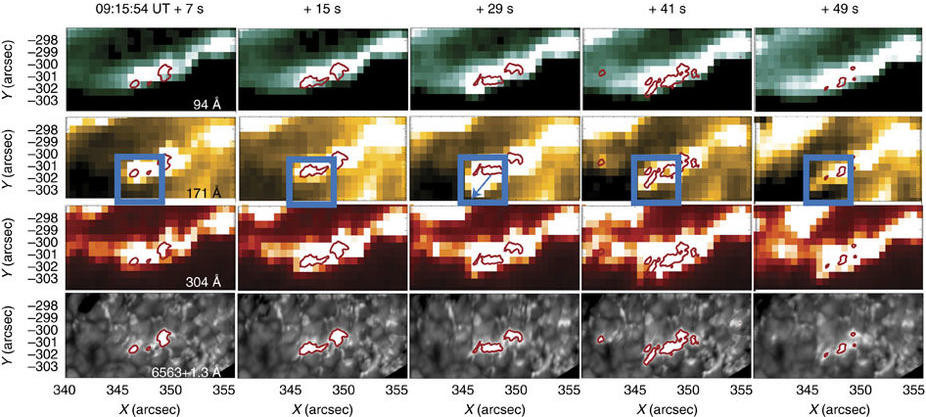
1 August 2018: Malcolm Druett joined the ISP as a Post Doc.
1 August 2018: Roberta Morosin joined the ISP as a PhD student.
8 February 2018: Rahul Yadav joined the ISP as a Post Doc.
12 December 2017: The Institute for Solar Physics of the Department of Astronomy announces three postdoc positions for the following projects:
1 December 2017: We announce a PhD position to study the physics of active region and flares in the solar chromosphere. This project involves modelling of very high resolution spectropolarimetric observations acquired with the CRISP and CHROMIS instruments at the Swedish 1-m Solar Telescope (SST) and with NASA's IRIS satellite. The selected candidate will compute and analyze empirical 3D models from these observations using data inversion techniques.
21 September 2017: Sepideh Kianfar joined the ISP as a PhD student.
6 September 2017: Jaime de la Cruz Rodriguez has been awarded
the
prestigious European
Research Council Starting Grant (€1.5 million) for the
project "SUNMAG: Understanding magnetic field regulated heating
and explosive events in the solar chromosphere".

27 June 2017: Shining a light on solar flares. This paper
resolves the puzzle of large red shifts of hydrogen Hα line
emission in flares by proving that short (10s) injections of
super-energetic electron beams, or solar energetic particles (SEPs)
can be responsible for a hydrogen emission from the flaring
chromosphere as well as for the extra Ultra-Violet emission (EUV)
from the flaring corona. The research relied upon AIA/SDO and the
Swedish 1-meter Solar Telescope. It was published by PhD student
Malcolm Druett (Northumbria University, Newcastle upon Tyne, UK) et
al. in
Nature Communications.
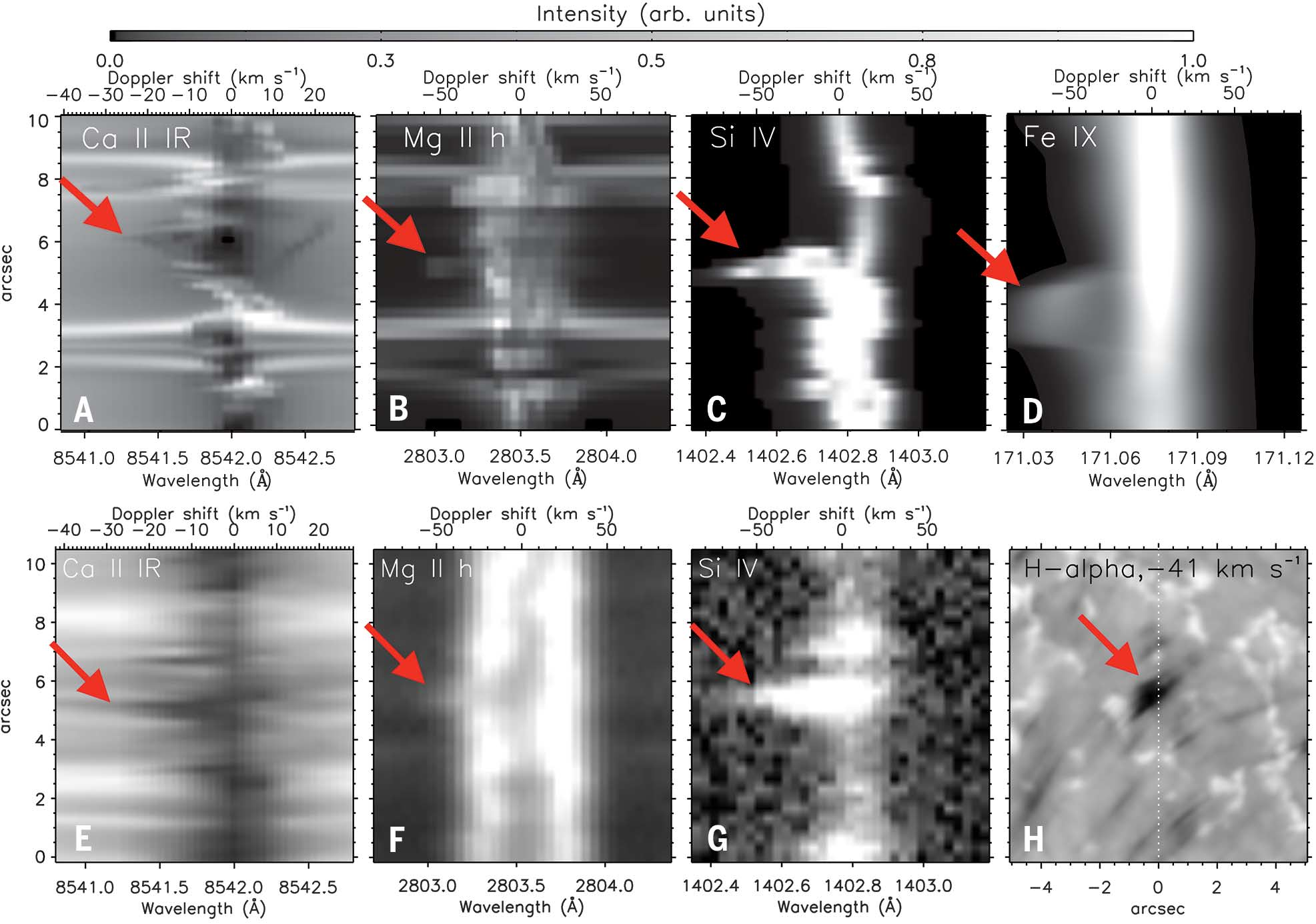 22 June 2017: Neutral particles are key to formation of
spicules. At any given moment, as many as 10 million spicules - wild
jets of solar material - burst from the sun's surface. They erupt as
fast as 100 km/s, and can reach lengths of 10 000 km before
collapsing. Scientists from the Bay Area Environmental Research (BAER)
Institute, the Lockheed-Martin Solar and Astrophysics Laboratory
(LMSAL), and the Institute of Theoretical Astrophysics of Oslo
University have revealed their origin.
A computer simulation shows how spicules form, helping scientists
understand how spicules can break free of the sun's surface and surge
upward so quickly.
Neutral particles provide the buoyancy the gnarled knots of magnetic
energy need to rise through the sun's boiling plasma and reach the
chromosphere. There, they snap into spicules, releasing both plasma
and energy. Friction between ions and neutral particles heats the
plasma even more, both in and around the spicules.
This work relied upon high-cadence observations from NASA's
Interface Region Imaging Spectrograph (IRIS) and the Swedish 1-meter
Solar Telescope. It was published by Dr. J. Martínez-Sykora (BAER and
LMSAL, USA) et al. in
Science. See also NASA's press
release.
22 June 2017: Neutral particles are key to formation of
spicules. At any given moment, as many as 10 million spicules - wild
jets of solar material - burst from the sun's surface. They erupt as
fast as 100 km/s, and can reach lengths of 10 000 km before
collapsing. Scientists from the Bay Area Environmental Research (BAER)
Institute, the Lockheed-Martin Solar and Astrophysics Laboratory
(LMSAL), and the Institute of Theoretical Astrophysics of Oslo
University have revealed their origin.
A computer simulation shows how spicules form, helping scientists
understand how spicules can break free of the sun's surface and surge
upward so quickly.
Neutral particles provide the buoyancy the gnarled knots of magnetic
energy need to rise through the sun's boiling plasma and reach the
chromosphere. There, they snap into spicules, releasing both plasma
and energy. Friction between ions and neutral particles heats the
plasma even more, both in and around the spicules.
This work relied upon high-cadence observations from NASA's
Interface Region Imaging Spectrograph (IRIS) and the Swedish 1-meter
Solar Telescope. It was published by Dr. J. Martínez-Sykora (BAER and
LMSAL, USA) et al. in
Science. See also NASA's press
release.
1 March 2017: Sanja Danilovic joined the ISP as a researcher.
28 February 2017: High-frequency torsional Alfvén waves
as an energy source for coronal heating.
An international team including researches from five countries and led
by Professor Gerry Doyle from Armagh Observatory and Planetarium
reports on a new discovery that may answer the long-standing question
of why is the sun's outer atmosphere or corona so hot.
The discovery, made using the Swedish 1-meter Solar Telescope at La
Palma, showing first ubiquitous presence of high frequency (~12-42
mHz) waves at numerous thin magnetic flux tubes in the quiet-Sun
magnetic network transferring energy into the overlying corona. They
serve as substantial sources of energy flux not only to heat the solar
corona but also to originate the supersonic solar wind.
This research was published by Dr. A.K. Srivastava (Department of
Physics, Indian Institute of Technology (BHU), India) et al.
in Nature's Scientific
Reports. See also the
team's press
release.
October 2016: Wallenberg funds new chromospheric
research project. Jorrit Leenaarts was awarded a SEK
33,950,000 (approximately EUR
3,500,000) grant
from the Knut and Alice Wallenberg Foundation for the five-year
project Fundamental
magnetic processes in the solar chromosphere. Together with the
premier developer in Europe of instruments for observational solar
physics,
September 2016: Gregal Vissers has joined the institute as a
Post Doc. Welcome Gregal!
August 2016: CHROMIS installed. Our
new Fabry-Perot-based spectrometer in the blue, CHROMIS, is now
successfully installed at the SST and is collecting science data.
CHROMIS is part of the five-year
CHROMOBS
project, generously funded by
the Knut and Alice
Wallenberg Foundation. The CHROMOBS project is an initiative
aiming at investigating the structure, dynamics and heating of the
upper solar chromosphere at unprecedented spatial and temporal
resolution. The main diagnostics are the Ca II H and K lines between
390 and 400 nm. The chromosphere is the highly dynamic and
magnetically dominated layer between the solar photosphere (the
visible solar surface) and the corona, and constitutes the interface
through which all non-thermal energy that heats the corona and drives
space weather is transported.
9 May 2016: Mercury transit. Weather permitting, we will observe
the transit with the Swedish 1-meter Solar Telescope..
April 2016: David Bühler has joined the institute as a
Post Doc. Welcome David!
January 2016: Sara Esteban Pozuelo has joined the
institute as a Post Doc. Welcome Sara!
3 November 2015: 4-year grant to Jaime. Today we celebrate Jaime de
la Cruz Rodriguez, whohas been awarded a 4-year grant from
Vetenskapsrĺdet (Swedish Research Council). Together with funds from
the astronomy department, this covers 4 years salary for Jaime as well
as for a PhD student.
16 October 2014: New findings on coronal heating. In a special
section of the journal Science, researchers this week present
new findings about the mechanisms that heat the solar
corona. One
of the articles in Science uses data from the Swedish 1-m Solar
Telescope (SST) to show that the solar chromosphere - the
atmospheric layer between the solar surface and the much hotter corona
- is full of twisting motions. These motions are a sign of magnetic
waves. Data with NASA s Interface Region Imaging Spectrograph (IRIS)
show that these motions strongly contribute to the heating the solar
plasma from 10,000 degrees to at least 1 million degrees.
The SST was earlier used to discover small-scale magnetic tornadoes
in the solar chromosphere (S. Wedemeyer-Böhm et al.,
2012, Nature 486:505) and has greatly contributed to our
understanding of the dynamic and magnetic solar atmosphere during the
last 12 years. Thanks to its instrumentation and high optical quality,
the SST remains the world leading ground-based solar telescope.
Dr. Jorrit Leenaarts from the Institute for Solar Physics
collaborates with the IRIS team on understanding the heating of the
outer solar atmosphere, and provided a theoretical foundation for
understanding the images taken by IRIS.
Contacts: Dr. Jorrit
Leenaarts jorrit.leenaarts@astro.su.se,
Prof. Göran
Scharmer scharmer@astro.su.se,
or Dr. Bart de Pontieu bdp@lmsal.com
May 2014: The institute is hiring more staff: J. Lewis Fox,
research engineer, starting August 2014; Jayant Joshi, post doc,
starting September 2014; Andrii V. Sukhorukov, post doc, starting
summer or early fall 2014. Welcome to the institute!
January 2014: The institute is expanding. We have recently hired
new staff: Jorrit Leenaarts, associate professor; Jaime de la Cruz
Rodriguez, post doc; Tomas Hillberg, data engineer; Tine Libbrecht,
PhD student. Welcome to the institute! We expect to recruit
additional staff in the near future; students, a research engineer,
and a post doc.
24 April 2013: Inauguration of the Institute for Solar Physics as a
national research infrastructure in association with the Stockholm
University Department of Astronomy.
April 2013: The Adaptive Optics system has been upgraded. The new
deformable mirror has 85 electrodes (the old one had 37). With its 85
subaperture Shack-Hartmann wavefront sensor, it has 84 controllable
modes and locks in seeing with r0 better than
5 cm. The new AO is available for all types of observations with the
Swedish 1-m Solar Telescope.
15 February 2013: Vasco Henriques successfully defended his
thesis.
17 December 2012: A new home for the Institute for Solar
Physics. From 1 January 2013, the Institute for Solar Physics
will be established at Stockholm University, which will then take over
the management from the Royal Swedish Academy of Sciences. At the same
time, the institute will become a Research Infrastructure under the
Swedish Research Council. This transfer will strengthen the institute
and several new student and scientist positions will be created.
Press
release at Stockholm University. (In Swedish.)
October 2012:
The
Knut and Alice Wallenberg Foundation has decided to award Göran
Scharmer a 26.3 MSEK grant for a 5-year project on "Dynamics of the
solar chromosphere".
March 2011: Gautam successfully defended his PhD thesis.
March 2011: Maria Tham presented her MSc thesis.
November 2010: Jaime successfully defendended his PhD thesis.
April 2010: The Institute for Solar Physics congratulates NASA and
the Solar Dynamics Observatory (SDO) team for the successful first
light event. Watch the wonderful movies and images of the solar
corona at the SDO site.
June 2008: Göran Scharmer
is the
first winner of the European Atronomical Society's newly created
Tycho Brahe Prize. The prize will be awarded to Prof. Scharmer at
the opening ceremony at the next European meeting in September.
April 2007: Pit
Sütterlin has joined the SST staff as Support Astronomer. For the 2007
season he will still have DOT duties but will help
with SST matters as time permits.
20 October 2005: Uppsala University announced
that it will confer the degree of Honorary Doctor of Science to Göran
Scharmer on 27 January 2006.
1 September 2005: Boris Gudiksen, our former PhD student, has
been awarded the "Naturvetarepris" for the best PhD dissertation ("The coronal
heating problem") in
physics in Sweden during 2004 from The Swedish Association of
Scientists (Naturvetareförbundet). We are extremely proud of his
accomplishments and convey our warmest congratulations.
9 March 2005: The Royal Swedish Academy of Sciences decided to
give Mats Löfdahl the Strömer-Ferrner award. Mats will receive the
award on 11 May.
September 2004: Göran Scharmer is
the 7th
Lennart Nilsson Award winner. He will receive the prize on 4
November 2004.
12 December 2003: We gratefully acknowledge a generous grant of
SEK 5.8 million from the Marianne and Marcus Wallenberg Foundation
(Marianne och Marcus Wallenbergs stiftelse) to be used for SST
instrumentation.
15 October 2003: Ghanjah Skĺnby-Mansour presented her masters's
thesis project, The fine structure of
penumbral grains.
25 April 2003: First light with new AO
system.
17 January 2003: Luc Rouppe van der Voort successfully defended
his thesis in
solar physics. Congratulations, Luc!
14 December 2002: We make the Dark Core
scientific data set public. More data to come from this location:
https://www.isf.astro.su.se/data/.
21 May 2002: Full aperture: The new telescope is now used with the
full 1-m aperture.
5 April 2002: Schupmann corrector works: G-band images
with secondary optics installed. Still with a stopped down
aperture (60 cm).
March 2002: Back in business: First light with the secondary
optics of the new telescope installed. Still with a stopped down
aperture (60 cm).
March 2002: First light: The new solar telescope saw
First Light on Saturday 2 March. The
aperture was stopped down to 60 cm pending installation of the cooling
system and the adaptive optics.
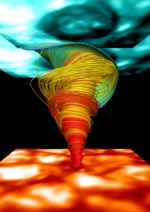 28 June 2012:
In the 28 June issue
of Nature, a team of
researchers from Norway, Germany, UK, and Sweden report
on magnetic solar tornadoes, discovered in data recorded with
the SST. Magnetic solar tornadoes resemble tornadoes on the Earth,
but have a magnetic skeleton and are hundreds to thousand times
larger in cross-sectional area. Although being small compared to the
whole Sun, one such observed tornado could occupy the surface area
equivalent of Europe or the USA.
28 June 2012:
In the 28 June issue
of Nature, a team of
researchers from Norway, Germany, UK, and Sweden report
on magnetic solar tornadoes, discovered in data recorded with
the SST. Magnetic solar tornadoes resemble tornadoes on the Earth,
but have a magnetic skeleton and are hundreds to thousand times
larger in cross-sectional area. Although being small compared to the
whole Sun, one such observed tornado could occupy the surface area
equivalent of Europe or the USA.
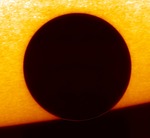 5-6 June 2012: Venus Transit Flashback.
The transit of Venus that occurs on June 5-6, 2012 is not observable
from La Palma and therefore there will be no SST imagery from this event.
We take the opportunity to show some remade movies from the last transit
which occurred on June 8, 2004.
5-6 June 2012: Venus Transit Flashback.
The transit of Venus that occurs on June 5-6, 2012 is not observable
from La Palma and therefore there will be no SST imagery from this event.
We take the opportunity to show some remade movies from the last transit
which occurred on June 8, 2004.
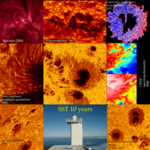 22 May
2012: SST 10 years.
Ten years ago the SST captured its first diffraction-limited image,
demonstrating the quality of the telescope. This was within days of
first light with its full aperture. During the past ten years the SST
has had its instrumentation continuously amended and improved.
Currently its adaptive optics is undergoing an upgrade which is
expected to increase the fraction of time with diffraction-limited
performance.
22 May
2012: SST 10 years.
Ten years ago the SST captured its first diffraction-limited image,
demonstrating the quality of the telescope. This was within days of
first light with its full aperture. During the past ten years the SST
has had its instrumentation continuously amended and improved.
Currently its adaptive optics is undergoing an upgrade which is
expected to increase the fraction of time with diffraction-limited
performance.
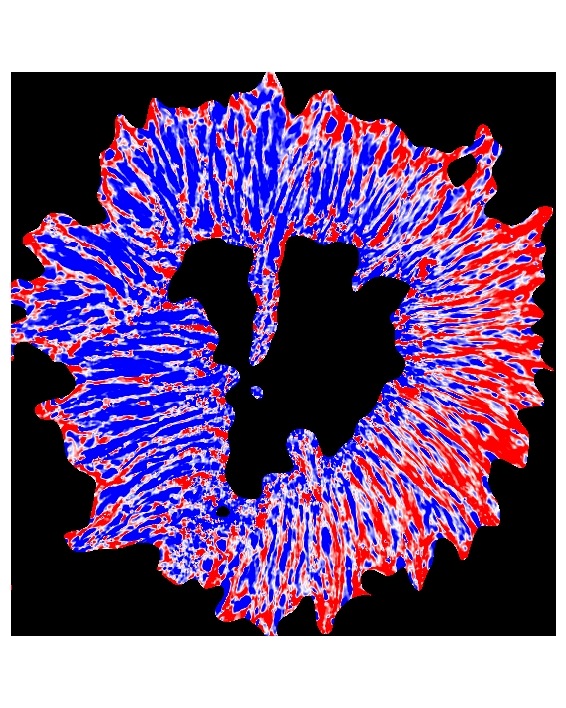 2 June 2011: Convective
downflows in a sunspot penumbra. Data from the CRISP
instrument at the SST show the presence of downflows in a sunspot
penumbra. The results are published as a Report in Science magazine.
The authors are: Göran B. Scharmer, Vasco M.J. Henriques, Dan
Kiselman, (all from the Institute for Solar Physics and the Department
of Astronomy at Stockholm University), and Jaime de la Cruz Rodríguez
(University of Oslo). The conclusion is that the observed system of
upflows and downflows must be convective in origin. This implies that
the penumbra is largely powered by convection and that the Evershed
effect is the horizontal component of these convective flows.
2 June 2011: Convective
downflows in a sunspot penumbra. Data from the CRISP
instrument at the SST show the presence of downflows in a sunspot
penumbra. The results are published as a Report in Science magazine.
The authors are: Göran B. Scharmer, Vasco M.J. Henriques, Dan
Kiselman, (all from the Institute for Solar Physics and the Department
of Astronomy at Stockholm University), and Jaime de la Cruz Rodríguez
(University of Oslo). The conclusion is that the observed system of
upflows and downflows must be convective in origin. This implies that
the penumbra is largely powered by convection and that the Evershed
effect is the horizontal component of these convective flows.
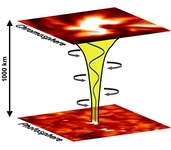 20 Mar 2009: Alfvén
waves, Science
323 (5921).
New images from the Swedish 1-meter Solar Telescope on La Palma show
the presence of magnetic waves, Alfvén waves, in the lower solar
atmosphere. The authors, a collaboration of scientist from Queens
University, Belfast, the University of Sheffield, and California State
University Northridge, conclude that these waves could heat the solar
corona, which would explain the coronal temperature of 1 million K or
more, while the solar surface, the photosphere, is "only" 6000 K.
20 Mar 2009: Alfvén
waves, Science
323 (5921).
New images from the Swedish 1-meter Solar Telescope on La Palma show
the presence of magnetic waves, Alfvén waves, in the lower solar
atmosphere. The authors, a collaboration of scientist from Queens
University, Belfast, the University of Sheffield, and California State
University Northridge, conclude that these waves could heat the solar
corona, which would explain the coronal temperature of 1 million K or
more, while the solar surface, the photosphere, is "only" 6000 K.
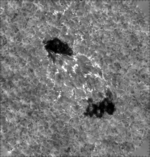 Apr 2008: CRISP! During April 2008,
the CRisp
Imaging SpectroPolarimeter (CRISP) was installed at the SST on La
Palma. The tunable filter part of this system is a dual Fabry-Pérot
Interferometer (FPI) system, usable from 510 to 860 nm with
0.3-0.9 nm wide pre-filters. It has a compact telecentric optical
design with a minimum number of optical surfaces and high overall
transmission. Polarization measurements are made by liquid crystal
(LC) modulation and a polarizing beam splitter, located close to the
final focal plane and feeding two 1k×1k-pixel Sarnoff CCD
cameras. MOMFBD
image restoration is aided with a third CCD providing broad-band
images synchronized with the two narrowband images and recorded
through the pre-filter of the FPI system. The optimization of the FPI
system is described by Göran Scharmer
(2006,
A&A 447, 1111), the overall design and details of CRISP will
be described in a forthcoming publication and also provided on our
web site.
Apr 2008: CRISP! During April 2008,
the CRisp
Imaging SpectroPolarimeter (CRISP) was installed at the SST on La
Palma. The tunable filter part of this system is a dual Fabry-Pérot
Interferometer (FPI) system, usable from 510 to 860 nm with
0.3-0.9 nm wide pre-filters. It has a compact telecentric optical
design with a minimum number of optical surfaces and high overall
transmission. Polarization measurements are made by liquid crystal
(LC) modulation and a polarizing beam splitter, located close to the
final focal plane and feeding two 1k×1k-pixel Sarnoff CCD
cameras. MOMFBD
image restoration is aided with a third CCD providing broad-band
images synchronized with the two narrowband images and recorded
through the pre-filter of the FPI system. The optimization of the FPI
system is described by Göran Scharmer
(2006,
A&A 447, 1111), the overall design and details of CRISP will
be described in a forthcoming publication and also provided on our
web site.
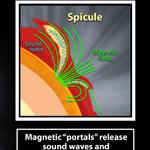 30 May 2007:
Corona, NASA
press release. A team of scientists funded by NASA and the NSF
have discovered what shapes and powers the chromosphere, a thin region
of the sun's atmosphere which appears as a ruby red "ring of fire"
around the moon during a total solar eclipse. The chromosphere,
so-called because of its color, is a significant source of variations
in the sun's ultraviolet (UV) radiation that may contribute to climate
change on Earth. It is a 10,000C layer sandwiched between 6,000C solar
surface and the 1,000,000C outer atmosphere (corona) - that's like
standing next to a fire and getting warmer as you move away from it
instead of cooler: a puzzle that has left solar physicists scratching
their heads for decades. Sound waves and the ever-changing solar
magnetic field have each been proposed as potential drivers of this
counter-intuitive temperature change in the past. The new result shows
that both have a part to play in creating the change, offering a
significant leap in the understanding of one of the sun's remaining
great mysteries.
30 May 2007:
Corona, NASA
press release. A team of scientists funded by NASA and the NSF
have discovered what shapes and powers the chromosphere, a thin region
of the sun's atmosphere which appears as a ruby red "ring of fire"
around the moon during a total solar eclipse. The chromosphere,
so-called because of its color, is a significant source of variations
in the sun's ultraviolet (UV) radiation that may contribute to climate
change on Earth. It is a 10,000C layer sandwiched between 6,000C solar
surface and the 1,000,000C outer atmosphere (corona) - that's like
standing next to a fire and getting warmer as you move away from it
instead of cooler: a puzzle that has left solar physicists scratching
their heads for decades. Sound waves and the ever-changing solar
magnetic field have each been proposed as potential drivers of this
counter-intuitive temperature change in the past. The new result shows
that both have a part to play in creating the change, offering a
significant leap in the understanding of one of the sun's remaining
great mysteries.
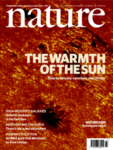 14 Sep 2006: Faculae,
Nature 443.
Sunspots and faculae modulate the total solar energy output and they
are thus relevant for studies of climate change. A recent article in
Nature by Foukal et al. reviews the situation. That issue of Nature
has an SST image of spots and faculae on its cover, thus
highlighting the importance of this telescope in the quest for
understanding these solar phenomenae.
14 Sep 2006: Faculae,
Nature 443.
Sunspots and faculae modulate the total solar energy output and they
are thus relevant for studies of climate change. A recent article in
Nature by Foukal et al. reviews the situation. That issue of Nature
has an SST image of spots and faculae on its cover, thus
highlighting the importance of this telescope in the quest for
understanding these solar phenomenae.
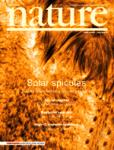 28 Jul
2004: Spicules, Nature
430.
Spicules are dynamic jets propelled upwards (at speeds of
approximately 20 km s-1) from the solar 'surface'
(photosphere) into the magnetized low atmosphere of the Sun. They
carry a mass flux of 100 times that of the solar wind into the low
solar corona. With diameters close to observational limits (< 500
km), spicules have been largely unexplained since their discovery in
1877: none of the existing models can account simultaneously for their
ubiquity, evolution, energetics and recently discovered periodicity.
In this Nature paper, the authors report a synthesis of modelling and
high-spatial-resolution SST observations in which numerical
simulations driven by observed photospheric velocities directly
reproduce the observed occurrence and properties of individual
spicules.
28 Jul
2004: Spicules, Nature
430.
Spicules are dynamic jets propelled upwards (at speeds of
approximately 20 km s-1) from the solar 'surface'
(photosphere) into the magnetized low atmosphere of the Sun. They
carry a mass flux of 100 times that of the solar wind into the low
solar corona. With diameters close to observational limits (< 500
km), spicules have been largely unexplained since their discovery in
1877: none of the existing models can account simultaneously for their
ubiquity, evolution, energetics and recently discovered periodicity.
In this Nature paper, the authors report a synthesis of modelling and
high-spatial-resolution SST observations in which numerical
simulations driven by observed photospheric velocities directly
reproduce the observed occurrence and properties of individual
spicules.
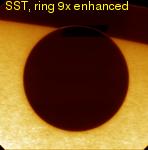 8 Jun 2004: We observed the Venus transit with the Swedish 1-m
Solar Telescope (SST) in La Palma. Here is a gallery of images and
movies from the event.
8 Jun 2004: We observed the Venus transit with the Swedish 1-m
Solar Telescope (SST) in La Palma. Here is a gallery of images and
movies from the event.
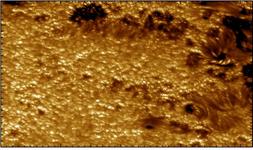 17 Jun 2003: 3D
granulation, NASA
press release.
17 Jun 2003: 3D
granulation, NASA
press release.
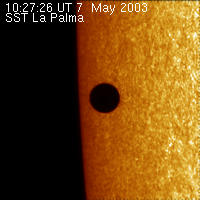 7 May 2003:
We observed the Mercury transit with the Swedish 1-m Solar Telescope (SST) in La
Palma. Here is a gallery of images and movies from the event.
7 May 2003:
We observed the Mercury transit with the Swedish 1-m Solar Telescope (SST) in La
Palma. Here is a gallery of images and movies from the event.
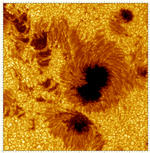 14 Nov 2002: Best ever view of
sunspots, Nature
420
14 Nov 2002: Best ever view of
sunspots, Nature
420
In May 2002, the Swedish 1-m Solar Telescope started
operation with its full aperture. During the first few months of
operation we collected many solar images with unprecedented spatial
resolution, estimated to approximately 90 km. Some of these show inner
structure, a dark core, in the hitherto unresolved filaments in
sunspot penumbrae. The dark-cored filaments were an unexpected
discovery, that we have published as a Letter in Nature, "Dark cores
in sunspot penumbral filaments".
Time-stamp: <2018-10-26 14:16:47 mats>